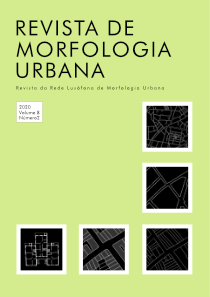Abstract
This article focuses on the influence of the urban form on the population's access to equipment and its objective is to systematize a methodology for assessing equity in access to public health equipment, based on configurational models. The study analyzes how the population of Porto Alegre is located in relation to accessing primary health care units (US). The empirical data comes from the municipal database GEOSAÚDE (2010) and IBGE (Census 2010). The methodology involves calculating the targeted accessibility of demands (residents) to offers (US), based on the Spatial Opportunity model. The modeling outcomes allowed identifying the spatial opportunity of the population and, in a second moment, to discuss the equity of access of the priority population profile. The equity analysis was carried out in a comparative way (general average for the city and some selected neighborhoods). The methodology showed its potential to analyze and discuss the complexity of the population's access patterns to health services and can also contribute to test alternative scenarios, supporting decision making.
References
Brock, A. L. (2016). Aglomerações Urbanas: uma análise de efeitos configuracionais na estrutura espacial de cidades aglomeradas. Dissertação (Mestrado) – Curso de Urbanismo, PROPUR, Universidade Federal do Rio Grande do Sul, Brasil.
Castro, S. S., Lefèvre, F., Lefèvre A. M. C. e Cesar, C. L. G. (2011) Acessibilidade aos serviços de saúde por pessoas com deficiência. Revista de Saúde Pública, São Paulo, 1 (45), 99-105. https://doi.org/10.1590/S0034-89102010005000048.
Crucitti, P., Latora, V. e Porta, S. (2006) Centrality Measures in Spatial Networks of Urban Streets. Physics Review. E 73 (036125), 1-4. https://doi.org/10.1103/PhysRevE.73.036125.
Donabedian A. (1973) The assessment of need. In: Donabedian A, (ed.). Aspects of medical care administration. Cambridge, Harvard University Press; 1973. p. 58-77.
Fainstein, S. S. (2013). The just city. International Journal Of Urban Sciences, 18 (1), 1-18. http://dx.doi.org/10.1080/12265934.2013.834643.
Ferreira, R. V. e Raffo, J. G. (2012) O uso dos Sistemas de Informação Geográfica (SIG) no estudo da acessibilidade física aos serviços de saúde pela população rural: revisão da literatura. Hygeia, Revista Brasileira de Geografia Médica e da Saúde 8 (15), 177–189. Disponível em: <http://www.seer.ufu.br/index.php/hygeia/article/view/34540/20580>. [Consultado em 10 de abril de 2018].
Geurs, K. e Eck Jr, R. (2001) Acessibillity measures: review and aplications: Evoluation of accessibility impacts of land-use transport scenarios, and related social and economic impacts. Bilthoven, Rivm. Disponível em: <https://www.rivm.nl/dsresource?objectid=171931c0-1023-4d50-8a3e-99f8ea126b74&type=org&disposition=inline>. [Consultado em: 1 abril de 2018].
Giovanella, L., Mendonça, M.H.M., Matta, G.C. e Gondim, R, (2018). Atenção Primária à Saúde no Brasil: conceitos, práticas e pesquisa. In: Giovanella, L. et al. Políticas e Sistema de Saúde no Brasil. 2. Rio de Janeiro, Fiocruz.
Guagliardo, M. F. (2004). Spatial accessibility of primary care: Concepts, methods and challenges. International Journal of Health Geographics, 3, 1–13. Disponível em: https://doi.org/10.1186/1476-072X-3-3.
Haggett, P. e Chorley, R. J. (1969). Network analysis in geography. London, Edward Arnold.
Hansen, W. G. (2012) How Accessibility Shanpes Land Use. Journal of The American Institute of Planners, 13 (11) 73–76. Disponível em: https://doi.org/10.1080/01944365908978307.
Hillier, B. (2007). Space is the Machine. London, Space Syntax Lab. ISBN: 978-0-9556224-0-3. Disponível em: https://spaceisthemachine.com/
Ingram, D. R. (1971) The concept of accessibility: A search for an operational form. Regional Studies, 5 (2) 101–107. Disponível em: https://doi.org/10.1080/0959523710018513
Intituto Brasileiro de Geografia e Estatística (IBGE). (2011) Censo Demográfico 2010. Rio de Janeiro.
Krafta, R. (1996). Urban convergence: morphology and attraction. Environment and Planning B: Planning and Design 23, 37-48. Disponível em: https://doi.org/10.1068/b230037
Krafta, R. (1997) Avaliação de desempenho urbano. In: ENCONTRO NACIONAL DA ANPUR, 7, 1997, Recife. Anais do VII Encontro Nacional da Anpur.
Krafta, R. (2014). Notas de Aula de Morfologia Urbana. Porto Alegre, Editora da UFRGS.
Krafta, R. e Spritzer, A. (2018) Software Numerópolis – Mapeamento do Desempenho Urbano. Programa de Pós-Graduação em Planejamento Urbano e Regional - PROPUR/UFRGS.
Luo, W. e Qi, Y. (2009). An enhanced two-step floating catchment area (E2SFCA) method for measuring spatial accessibility to primary care physicians. Health and Place, 15(4), 1100–1107. Disponível em: https://doi.org/10.1016/ j.healthplace.2009.06.002.
Luo, W. e Wang, F. (2003).Spatial accessibility to primary care and physician shortage area designation: a case study in Illinois with GIS approaches.In: Skinner,R.,Khan,O. (eds.) Geographic Information Systems and Health Applications. Hershey ,PA, Idea Group Publishing, pp. 260–278.
Neutens T. (2015). Accessibility, equity and health care: review and research directions for transport geographers. Journal of Transport Geography 43, 14–27. Disponível em: http://dx.doi.org/ 10.1016/j.jtrangeo.2014.12.006.
Mafra, M. R. P. e Chaves, M. M. N. (2004) O processo de territorialização e a atenção à saúde no programa saúde da família. Família, Saúde e Desenvolvimento 2 (8), 127-133. Disponível em: http://dx.doi.org/10.5380/fsd.v6i2.8065.
Observapoa - Observatório da Cidade de Porto Alegre (2019). Disponível em: http://portoalegreemanalise.procempa.com.br/?regiao=1_9_247.
Paez, A., Higgins, C.D. e Vivona, S.F. (2019). Demand and level of service inflation in Floating Catchment Area (FCA) methods. PLoS ONE 14(6): e0218773. Disponível em: https://doi.org/10.1371/ journal.pone.0218773.
QGIS. Sistema de Informações Geográficas do QGIS. Projeto Código Aberto Geospatial Foundation. (2019). Disponível em: http://qgis.osgeo.org.
SMS - Secretaria Municipal de Saúde, Prefeitura Municipal de Porto Alegre (2019). Disponível em: http://www2.portoalegre.rs.gov.br/sms/default.php?p_secao=828.
Talen, E. (1998) Visualizing Fairness: Equity Maps for Planners. Journal Of The American Planning Association. 64 (1), 22-38. https://doi.org/10.1080/ 01944369808975954
Travassos, C. (1997) Equidade e o Sistema Único de Saúde: uma contribuição para debate. Cadernos de Saúde Pública, 13 (2), 325-330. Disponível em: http://dx.doi.org/10.1590/s0102-311x1997000200024.
Travassos, C. e Martins, M. (2004) Uma revisão sobre os conceitos de acesso e utilização de serviços de saúde. Cadernos de Saúde Pública, 20 (2), 190-198. Disponível em:http://dx.doi.org/10.1590/ s0102-311x2004000800014.

This work is licensed under a Creative Commons Attribution 4.0 International License.
Copyright (c) 2020 Tiago Silveira, Clarice Maraschin


